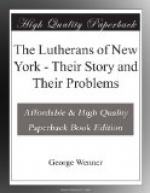Such things as social service, church extension or confessional questions had not yet begun to disturb the churches. Our people had all the time they wanted therefore for controversy on the undying question of the relative importance of the English and German languages. This, as we have seen, led to a lawsuit, the sale of a church and the permanent rupture of a historic congregation. We lost one English congregation, Zion, disbanded another, St. Matthew’s, and sent away enough English members besides to constitute St. Stephen’s Episcopal Church on Chrystie Street.
Such, in brief, is the story of the Lutherans of New York during the first third of the nineteenth century. In the Fatherland great events were taking place and history was making rapid strides. The war of liberation was decided by the battle of Leipzig and the defeat of Napoleon. But the hopes for social and political improvement were disappointed by reactionary movements and economic distress. A new emigration to “the land of unbounded possibilities” began. In 1821-22 it amounted to 531, in 1834-35 it was 25,997. Among the immigrants were many who in various capacities became empire builders in America. But in all that related to the Lutheran church New York at this time took a subordinate place. Philadelphia was the first city of the land. The construction of railroads and the opening of the Erie Canal carried the active and ambitious men far into the interior. The church life of New York still flowed in sluggish currents. After 190 years, from 1648, when the first appeal for a minister was sent to Amsterdam, to 1838, our enrollment consisted of two congregations, the German-English church of St. Matthew, and the English church of St. James.
In the Nineteenth Century 1839-1865
Immigration began to assume large proportions. It did not reach its climax until the following period, but it was sufficiently large to awaken attention. In 1839 21,028 immigrants arrived here from Germany; in 1865, at the close of the Civil War, 83,424. Most of these were bound for the interior, but many who had only stopped to rest a while in New York decided to make this their home.
The East Side became a little Germany and even on the West Side Germans began to appear in increasing numbers.
At the beginning of this period an event occurred, unnoticed at the time, which proved to be the beginning of a great movement, “a cloud out of the sea, as small as a man’s hand.” In 1839 a thousand exiles arrived from Germany under the leadership of Pastor Grabau. Most of them went to the interior, some to Buffalo, others, the wealthier members, to the neighborhood of Milwaukee. Ten or a dozen families remained in New York with a pastor named Maximilian Oertel. Their services were held in a hall at the corner of Houston Street and Avenue A. Doubtless none of their contemporaries ever dreamed that this insignificant congregation was related to one of the larger movements of church history.




